LG Electronics USA F156XJ Microwave Oven User Manual
LG Electronics USA Microwave Oven Users Manual
Users Manual

Microwave Oven
Owner's Manual
Microwave Oven
Keep instructions for future reference.
Be sure manual stays with oven.
Contents
Important Safety Instructions ................................................................2-4
Installation ................................................................................................5
Other Helpful Information......................................................................6-7
Cooking Utensils ......................................................................................8
Set up.......................................................................................................9
Specification...........................................................................................10
Feature Diagram.....................................................................................11
Turntable Installation ..............................................................................11
Control Panel .........................................................................................12
Operating Instructions.......................................................................13-19
Fresh Vegetable Chart ...........................................................................20
Care and Cleaning .................................................................................21
Troubleshooting......................................................................................22
Warranty.................................................................................................24
A/02/03 ©2003 Maytag Appliance Sales Co. Part No. /
Installer: Please leave this manual
with this appliance.
Consumer: Please read and keep
this manual for future reference.
Keep sales receipt and/or cancelled
check as proof of purchase.
If you have questions, write us
(include your model number and
phone number) or call:
Maytag Appliances Sales
Company
Attn: CAIR®Center
P.O. Box 2370
Cleveland, TN 37320-2370
1-800-688-1100 U.S.A. and
Canada
(Mon.-Fri., 8 am-8 pm Eastern
Time)
Internet: http://www.jennair.com
In our continuing effort to im-
prove the quality and perfor-
mance of our appliances, it
may be necessary to make
changes to the appliance with-
out revising this guide.
Model Number
Serial Number
Date of Purchase
3828W5A2901
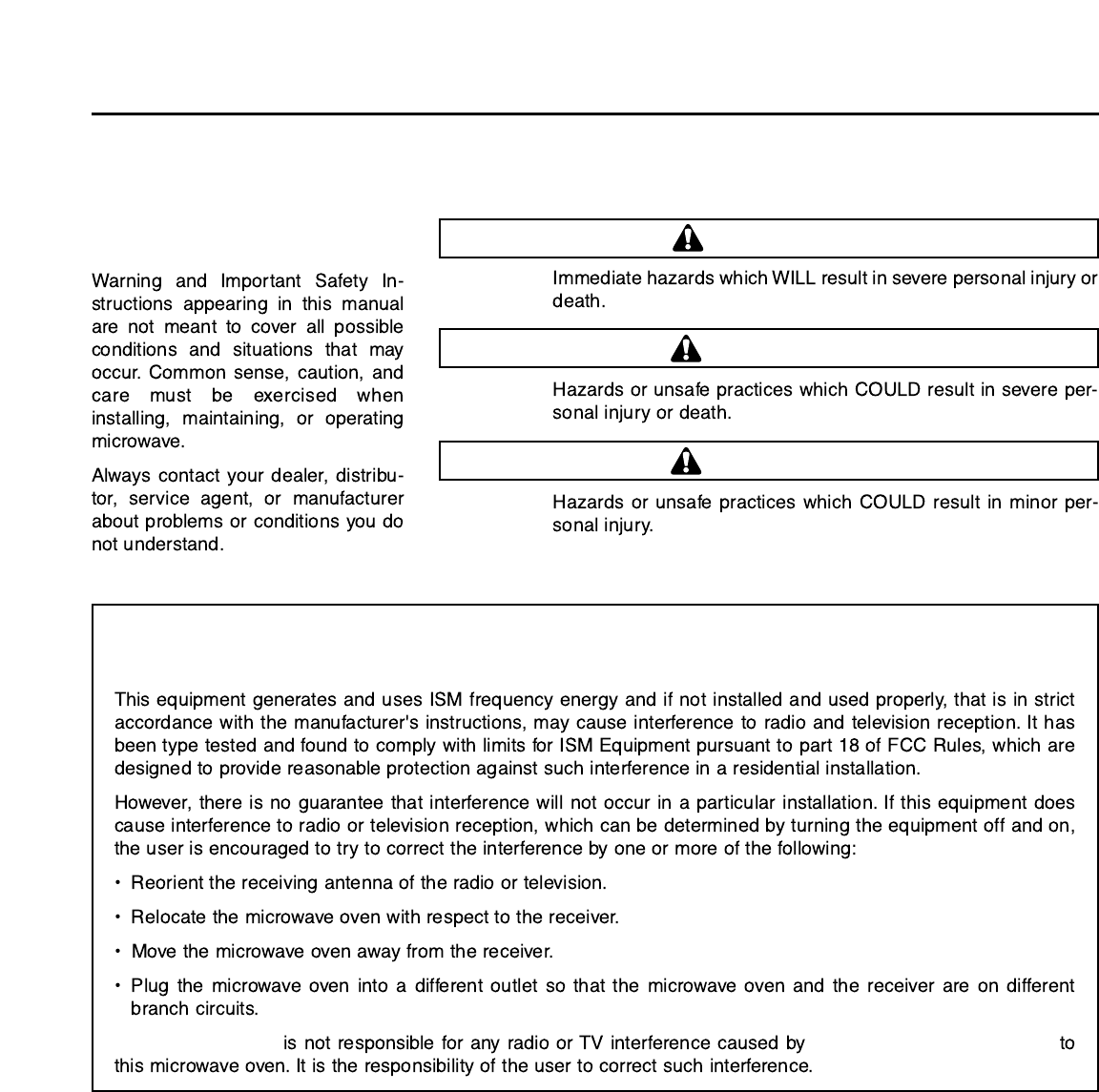
2
IMPORTANT SAFETY INSTRUCTIONS
What You Need
to Know About
Safety Instructions
Recognize Safety Symbols, Words, Labels
DANGER
DANGER—
WARNING
WARNING—
CAUTION
CAUTION—
SAVE THESE INSTRUCTIONS
FEDERAL COMMUNICATIONS COMMISSION RADIO FREQUENCY
INTERFERENCE STATEMENT ( U.S.A. ONLY)
The manufacturer unauthorized modification
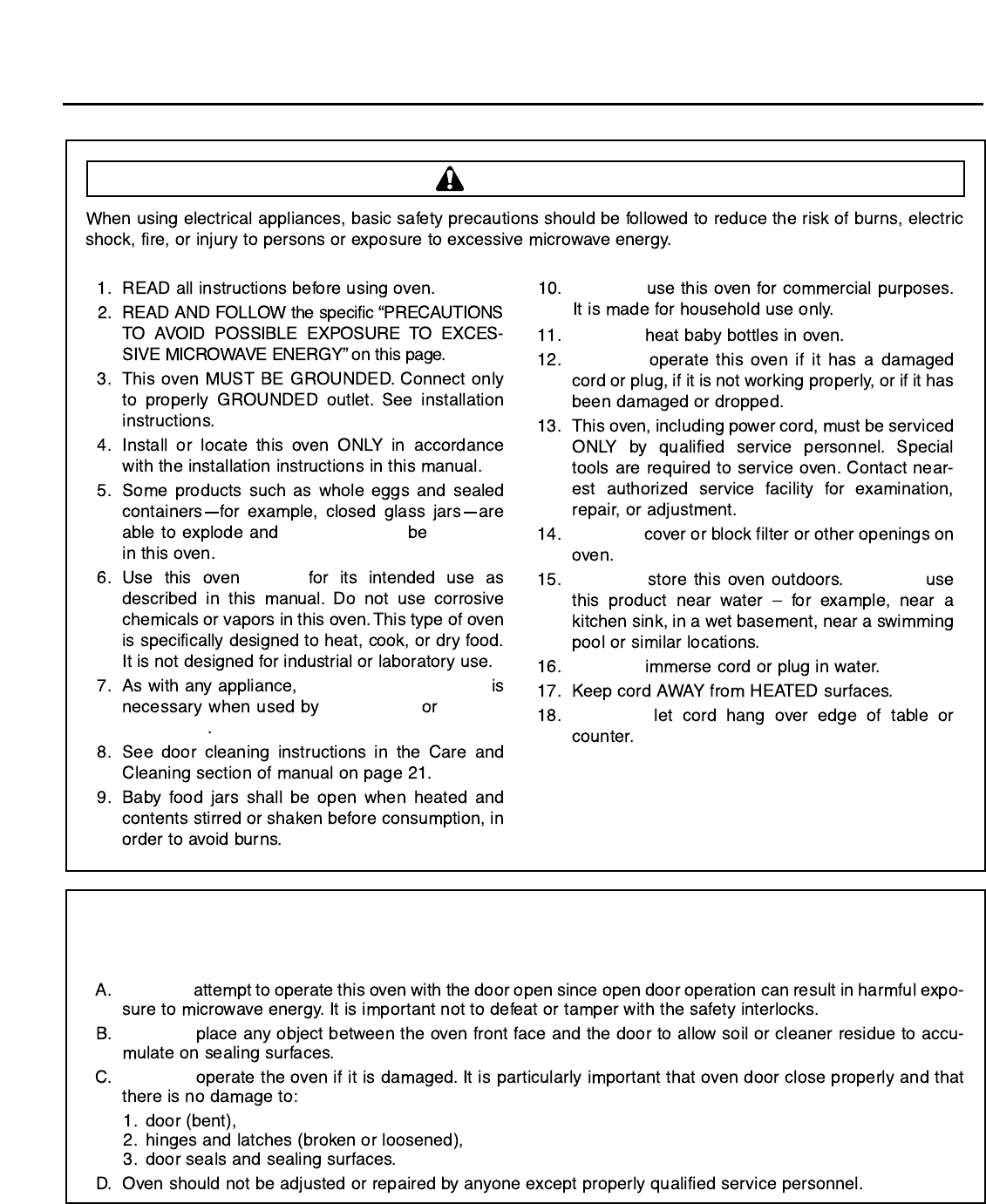
3
IMPORTANT SAFETY INSTRUCTIONS
PRECAUTIONS TO AVOID POSSIBLE EXPOSURE TO
EXCESSIVE MICROWAVE ENERGY
DO NOT
DO NOT
DO NOT
SAVE THESE INSTRUCTIONS
SHOULD NOT HEATED
ONLY
CLOSE SUPERVISION
CHILDREN INFIRM
PERSONS
DO NOT
DO NOT
DO NOT
DO NOT DO NOT
DO NOT
DO NOT
CAUTION
DO NOT
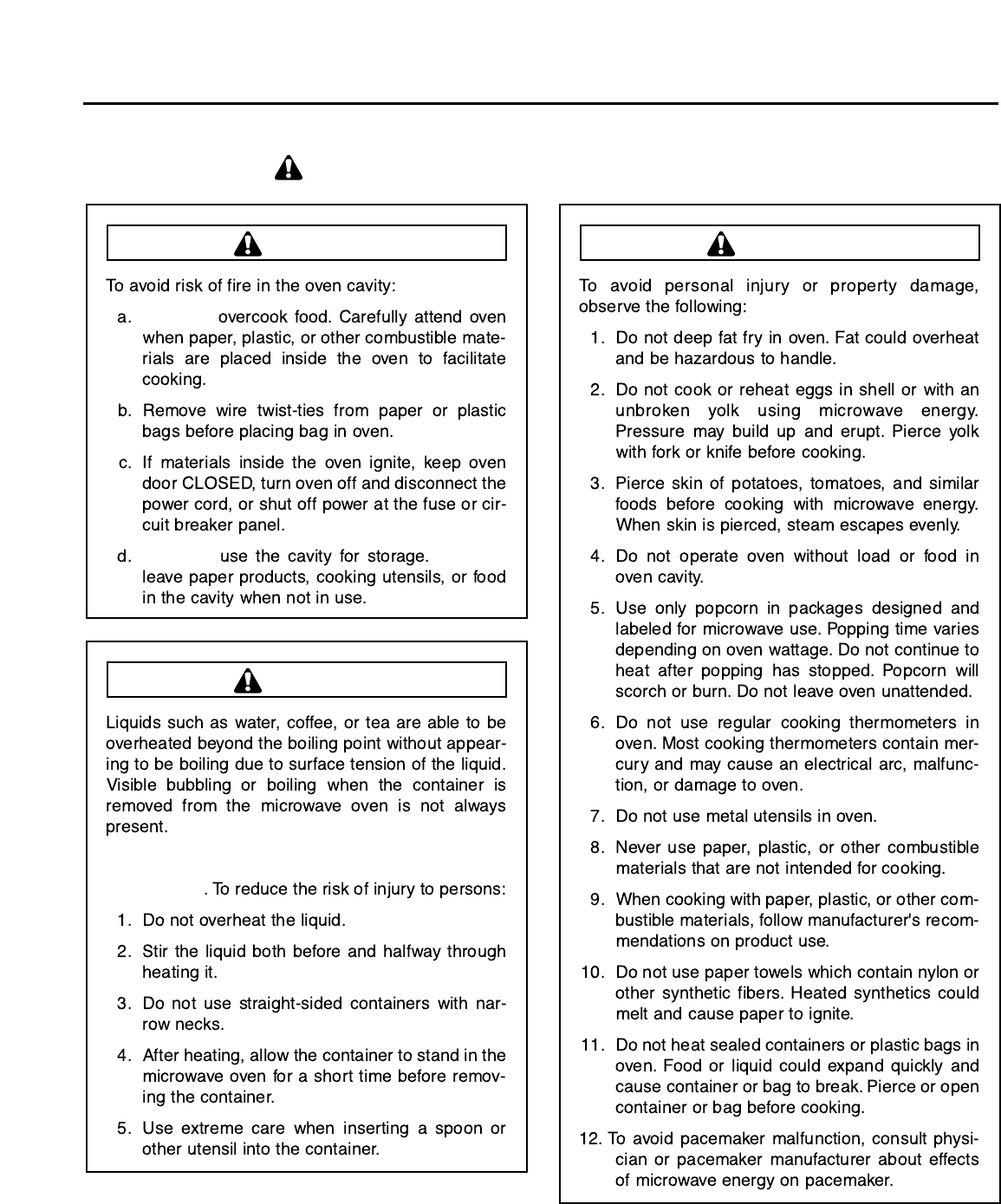
4
IMPORTANT SAFETY INSTRUCTIONS
SAVE THESE INSTRUCTIONS
Recognize this symbol as a SAFETY message
THIS COULD RESULT IN VERY HOT LIQ-
UIDS SUDDENLY BOILING OVER WHEN A
SPOON OR OTHER UTENSIL IS INSERTED INTO
THE LIQUID
WARNING
CAUTION
DO NOT
DO NOT DO NOT
WARNING
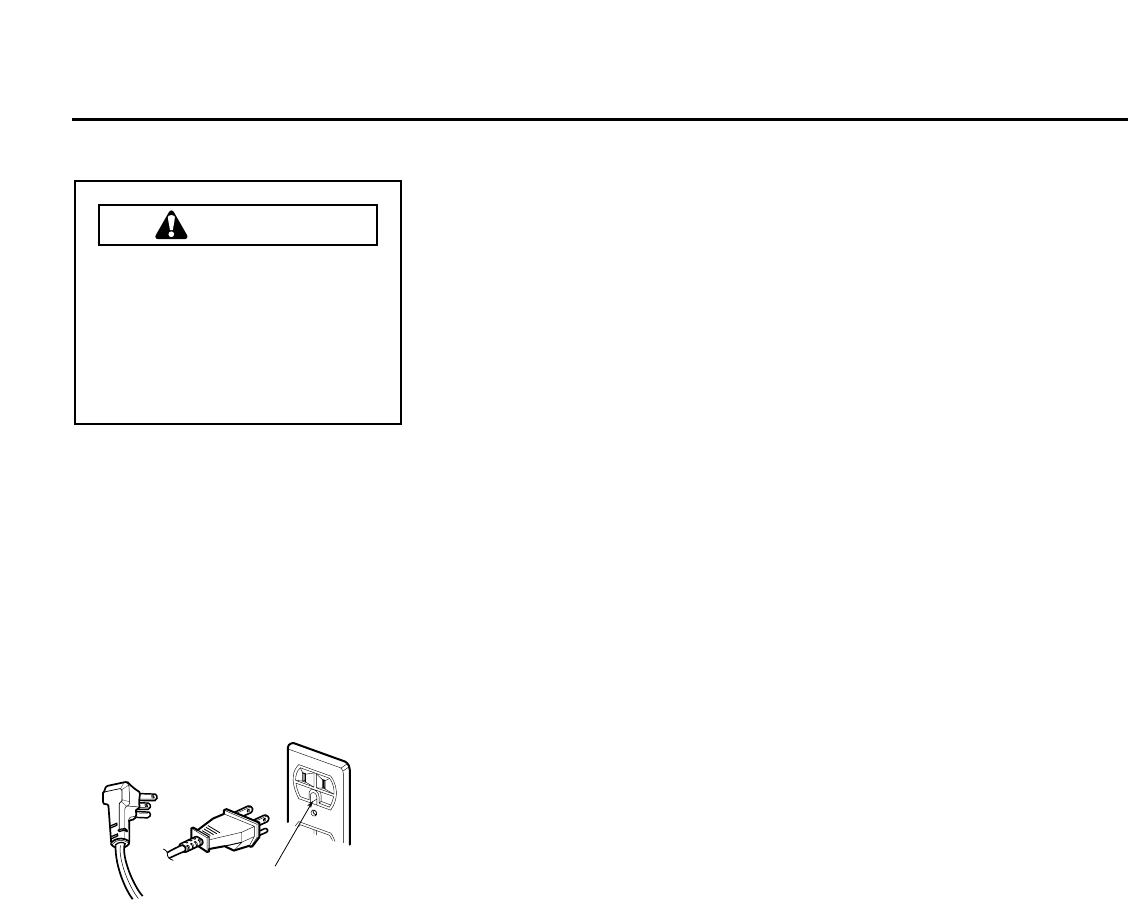
5
Installation
➣To avoid risk of electrical
shock or death, this oven
must be grounded.
➣To avoid risk of electrical
shock or death, do not alter
the plug.
WARNING
Grounding Instructions
Oven MUST be grounded.
Grounding reduces risk of electric
shock by providing an escape wire
for the electric current if an electrical
short occurs. This oven is equipped
with a cord having a grounding wire
with a grounding plug. The plug must
be plugged into an outlet that is prop-
erly installed and grounded.
Consult a qualified electrician or ser-
vicer if grounding instructions are not
completely understood, or if doubt
exists as to whether the oven is prop-
erly grounded.
Do not use an extension cord. If
the product power cord is too short,
have a qualified electrician install a
three-slot receptacle. This oven
should be plugged into a separate 60
hertz circuit with the electrical rating
as shown in specifications table.
When the microwave oven is on a cir-
cuit with other equipment, an
increase in cooking times may be
required and fuses can be blown.
Microwave operates on standard
household voltage, 110-120V.
CIRCUITS
For safety purposes this oven must
be plugged into a 15 or 20 Amp
circuit. No other electrical appliances
or lighting circuits should be on this
line. If in doubt, consult a licensed
electrician.
VOLTAGE
The voltage used at the wall recepta-
cle must be the same as specified on
the oven name plate located on the
front of oven cavity. Use of a higher
voltage is dangerous and may result
in a fire or other type of accident
causing oven damage. Low voltage
will cause slow cooking. In case your
microwave oven does not perform
normally in spite of proper voltage,
remove and reinsert the plug.
DO NOT BLOCK
AIR VENTS
All air vents should be kept clear dur-
ing cooking. If air vents are covered
during oven operation the oven may
overheat. In this case, a sensitive
thermal safety device automatically
turns the oven off. The oven will be
inoperable until it has cooled suffi-
ciently.
UNPACKING OVEN
• Inspect oven for damage such as
dents in door or inside oven cavity.
• Report any dents or breakage to
source of purchase immediately.
Do not attempt to use oven if
damaged.
• Remove all materials from oven
interior.
• If oven has been stored in extreme-
ly cold area, wait a few hours
before connecting power.
Ensure proper ground
exists before use

6
Other Helpful Information
GETTING THE BEST
RESULTS FROM YOUR
MICROWAVE OVEN
Keep an eye on things. The
instructions in this book have
been formulated with great care,
but your success in preparing food
depends, of course, on how much
attention you pay to the food as it
cooks. Always watch your food while
it cooks. Your microwave oven is
equipped with a light that turns on
automatically when the oven is in
operation so that you can see inside
and check the progress of your
recipe. Directions given in recipes to
elevate, stir, and the like should be
thought of as the minimum steps rec-
ommended. If the food seems to be
cooking unevenly, simply make the
necessary adjustments you think
appropriate to correct the problem.
Factors affecting cooking times.
Many factors affect cooking times.
The temperature of ingredients used
in a recipe makes a big difference in
cooking times. For example, a cake
made with ice-cold butter, milk, and
eggs will take considerably longer to
bake than one made with ingredients
that are at room temperature. All of
the recipes in this book give a range
of cooking times. In general, you will
find that the food remains under-
cooked at the lower end of the time
range, and you may sometimes want
to cook your food beyond the maxi-
mum time given, according to per-
sonal preference. The governing phi-
losophy of this book is that it is best
for a recipe to be conservative in giv-
ing cooking times. While under-
cooked food may always be cooked
a bit more, overcooked food is ruined
for good. Some of the recipes, partic-
ularly those for bread, cakes, and
custard, recommend that food be
removed from the oven when they
are slightly undercooked. This is not
a mistake. When allowed to stand,
usually covered, these foods will con-
tinue to cook outside of the oven as
the heat trapped within the outer por-
tions of the foods gradually travels
inward. If the foods are left in the
oven until they are cooked all the way
through, the outer portions will
become overcooked or even burned.
As you gain experience in using your
microwave oven, you will become
increasingly skillful in estimating both
cooking and standing times for vari-
ous foods.
SPECIAL TECHNIQUES
IN MICROWAVE
COOKING
Browning: Meats and poultry that
are cooked fifteen minutes or longer
will brown lightly in their own fat.
Foods that are cooked for a shorter
period of time may be brushed with a
browning sauce to achieve an appe-
tizing color. The most commonly
used browning sauces are
Worcestershire sauce, soy sauce,
and barbecue sauce. Since relatively
small amounts of browning sauces
are added to foods, the original flavor
of recipes is not altered.
Covering: A cover traps heat and
steam and causes food to cook more
quickly. You may either use a lid or
microwave cling-film with a corner
folded back to prevent splitting.
Covering with waxed paper:
Waxed paper effectively prevents
spattering and helps food retain
some heat. Since it makes a looser
cover than a lid or cling-film, it allows
the food to dry out slightly.
Wrapping in waxed paper or paper
towel: Sandwiches and many other
foods containing prebaked bread
should be wrapped prior to
microwaving to prevent drying out.
Arranging and spacing: Individual
foods such as baked potatoes, small
cakes, and hors d’oeuvres will heat
more evenly if placed in the oven and
equal distance apart, preferably in a
circular pattern. Never stack foods on
top of one another.
Stirring: Stirring is one of the most
important of all microwaving tech-
niques. In conventional cooking,
foods are stirred for the purpose of
blending. Microwaved foods, howev-
er, are stirred in order to spread and
redistribute heat. Always stir from the
outside towards the center as the
outside food heats first.
Turning over: Large, tall foods such
as roasts and whole chickens should
be turned so that the top and bottom
will cook evenly. It is also a good idea
to turn cutup chicken and chops.
Placing thicker portions near the
edge: Since microwaves are attract-
ed to the outside portion of foods, it
makes sense to place thicker por-
tions of meat, poultry and fish to the
outer edge of the baking dish. This
way, thicker portions will receive the
most microwave energy and the
foods will cook evenly.
Elevating: Thick or dense foods are
often elevated so that microwaves
can be absorbed by the underside
and center of the foods.
Piercing: Foods enclosed in a shell,
skin, or membrane are likely to burst
in the oven unless they are pierced
prior to cooking. Such foods include
both yolks and whites of eggs, clams
and oysters, and many whole veg-
etables and fruits.
Testing if cooked: Because foods
cook so quickly in a microwave oven,
it is necessary to test food frequently.
Some foods are left in the microwave
until completely cooked, but most
foods, including meats and poultry,
are removed from the oven while still
slightly undercooked and allowed to
finish cooking during standing time.
The internal temperature of foods will
rise between 5° F (3° C) and 15° F
(8° C) during standing time.

7
Standing time: Foods are often
allowed to stand for 3 to 10 minutes
after being removed from the
microwave oven. Usually the foods
are covered during standing time to
retain heat unless they are supposed
to be dry in texture (some cakes and
biscuits, for example). Standing
allows foods to finish cooking and
also helps flavors to blend and devel-
op.
HOW FOOD
CHARACTERISTICS
AFFECT MICROWAVE
COOKING
Density of foods: Light, porous food
like cakes and breads cook more
quickly than heavy, dense foods such
as roasts and casseroles. You must
take care when microwaving porous
foods that the outer edges do not
become dry and brittle.
Height of foods: The upper portion
of tall foods, particularly roasts, will
cook more quickly than the lower por-
tion. Therefore, it is wise to turn tall
foods during cooking, sometimes
several times.
Moisture content of foods: Since
the heat generated from microwaves
tends to evaporate moisture, relative-
ly dry foods such as roasts and some
vegetables should either be sprinkled
with water prior to cooking or covered
to retain moisture.
Bone and fat content of foods:
Bones conduct heat and fat cooks
more quickly than meat. Therefore,
care must be taken when cooking
bony or fatty cuts of meat that the
meats do not cook unevenly and do
not become overcooked.
NOTE: It is a common misconception
that microwaves cook food from the
inside out. This comes from heating
filled pastries with a high sugar con-
tent, like jelly doughnuts. The pastry
is cool but the filling is very hot! If you
cook a chicken or a roast, you’ll see
the outside is cooked first.
Shape of foods: Microwaves pene-
trate only about 1 inch (2.5cm) into
foods; the interior portion of thick
foods is cooked as the heat generat-
ed on the outside travels inward. In
other words, only the outer edge of
any food is actually cooked by
microwave energy; the rest is cooked
by conduction.
It follows then that the worst possible
shape for a food that is to be
microwaved is a thick cube. The cor-
ners will burn long before the center
is even warm. Round, thin, and ring
shaped foods cook most successful-
ly in the microwave.
Quantity of foods: The number of
microwaves in your oven remains
constant regardless of how much
food is being cooked. Therefore, the
more food you place in the oven, the
longer the cooking time. Remember
to decrease cooking times by at least
one-third when halving a recipe.
Other Helpful Information

8
Cooking Utensils
To avoid risk of personal injury or property damage, do not use stoneware, aluminum foil, metal utensils, or metal
trimmed utensils in the oven.
CAUTION
MICROWAVE-SAFE
UTENSILS
Never use metal or metal-trimmed
utensils in your microwave oven:
Microwaves cannot penetrate metal.
They will bounce off any metal object
in the oven and cause arcing, an
alarming phenomenon that resem-
bles lightning. Most heat-resistant
non-metallic cooking utensils are
safe for use in your microwave oven.
However, some may contain materi-
als that render them unsuitable as
microwave cookware. If you have
any doubts about a particular utensil,
there is a simple way to find out if it
can be used in your microwave oven.
Testing utensils for microwave
use: Place the utensil in question
next to a glass bowl filled with water
in the microwave oven. Microwave at
power HIGH for 1 minute. If the water
heats up but the utensil remains cool
to the touch, the utensil is
microwave-safe. However, if the
water does not change temperature
but the utensil becomes warm,
microwaves are being absorbed by
the utensil and it is not safe for use in
the microwave oven. You probably
have many items on hand in your
kitchen that can be used as cooking
equipment in your microwave oven.
Just read through the following
checklist.
1. Dinner plates: Many kinds of
dinnerware are microwave-safe.
If in doubt, consult the manu-
facturer's literature or perform
the microwave test, above.
2. Glassware: Glassware that is
heat-resistant is microwave-
safe. This includes all brands of
oventempered glass cookware.
However, do not use delicate
glassware, such as tumblers or
wine glasses, as these might
shatter as the food warms.
3. Paper: Paper plates and con-
tainers are convenient and
safe to use in your microwave
oven, provided the cooking
time is short and foods to be
cooked are low in fat and
moisture. Paper towels are also
very useful for wrapping foods
and for lining baking trays in
which greasy foods, such as
bacon, are cooked. In general,
avoid colored paper products as
the color may run.
4. Plastic storage containers:
These can be used to hold foods
that are to be quickly reheated.
However, they should not be
used to hold foods that will need
considerable time in the oven as
hot foods will eventually warp or
melt plastic containers.
5. Plastic cooking bags: These
are microwave-safe provided
they are specially made for
cooking. However, be sure to
make a slit in the bag so that
steam can escape. Never use
ordinary plastic bags for cooking
in your microwave oven, as they
will melt and rupture.
6. Plastic microwave cookware:
A variety of shapes and sizes of
microwave cookware is avail-
able. For the most part, you can
probably cook with items you
already have on hand rather
than investing in new kitchen
equipment.
7. Pottery, stoneware and
ceramic: Containers made of
these materials are usually fine
for use in your microwave oven,
but they should be tested to be
sure.

9
Set Up
Remove all packing material and accessories.
Examine the oven for any damage such as dents or broken door. Do not install it oven is damaged.
Note: This unit is not designed for 50 Hz or any circuit other than a 120-Volt/60-Hz AC circuit. This oven is designed
for Built-In installation.
• When installating in a Built-In situation, the oven reguires an opening for installation.
(27inch): 25-1/2 1/16”(W) X 22-1/2 1/16”(H) X 23-1/2”MIN(D)
(30inch): 28-1/2 1/16”(W) X 22-1/2 1/16”(H) X 23-1/2”MIN(D)
• Blocking the intake and/or outlet opening can damage the oven.
• Plug your oven into a standard 120-Volt/60-Hz house hold outlet.
Be sure the electrical circuit is at least 15 amperes and that your microwave oven is the only appliance on the circuit.
Built-In Installation

10
Specification
• Specifications subject to change without notice.
* According to IEC 60705 test procedures. The IEC 60705 test procedure is an internationally recognized method of
rating microwave voltage output.
Model:
Power Source:
Input Current
Power Consumption:
Output:
Oven Capacity:
Turntable Diameter:
Weight: Approx
Dimension
(Cutout)
Dimension
(Overall)
JMC8127DDB/W/Q/S
AC 120V, 60Hz
13A
1500W
1000W*
1.5 cu.ft
12-3/4”
DDB/W/Q: 69.8 lbs
DDS: 71.8 lbs
W 25-1/2 1/16”
H 22-1/2 1/16”
D 23-1/2” MIN
W 26-3/4”
H 23-7/16”
D 20-3/16”
JMC8130DDB/W/Q/S
AC 120V, 60Hz
13A
1500W
1000W*
1.5 cu.ft
12-3/4”
DDB/W/Q: 76.7 lbs
DDS: 78.7 lbs
W 28-1/2 1/16”
H 22-1/2 1/16”
D 23-1/2” MIN
W 29-3/4”
H 23-7/16”
D 20-3/16”
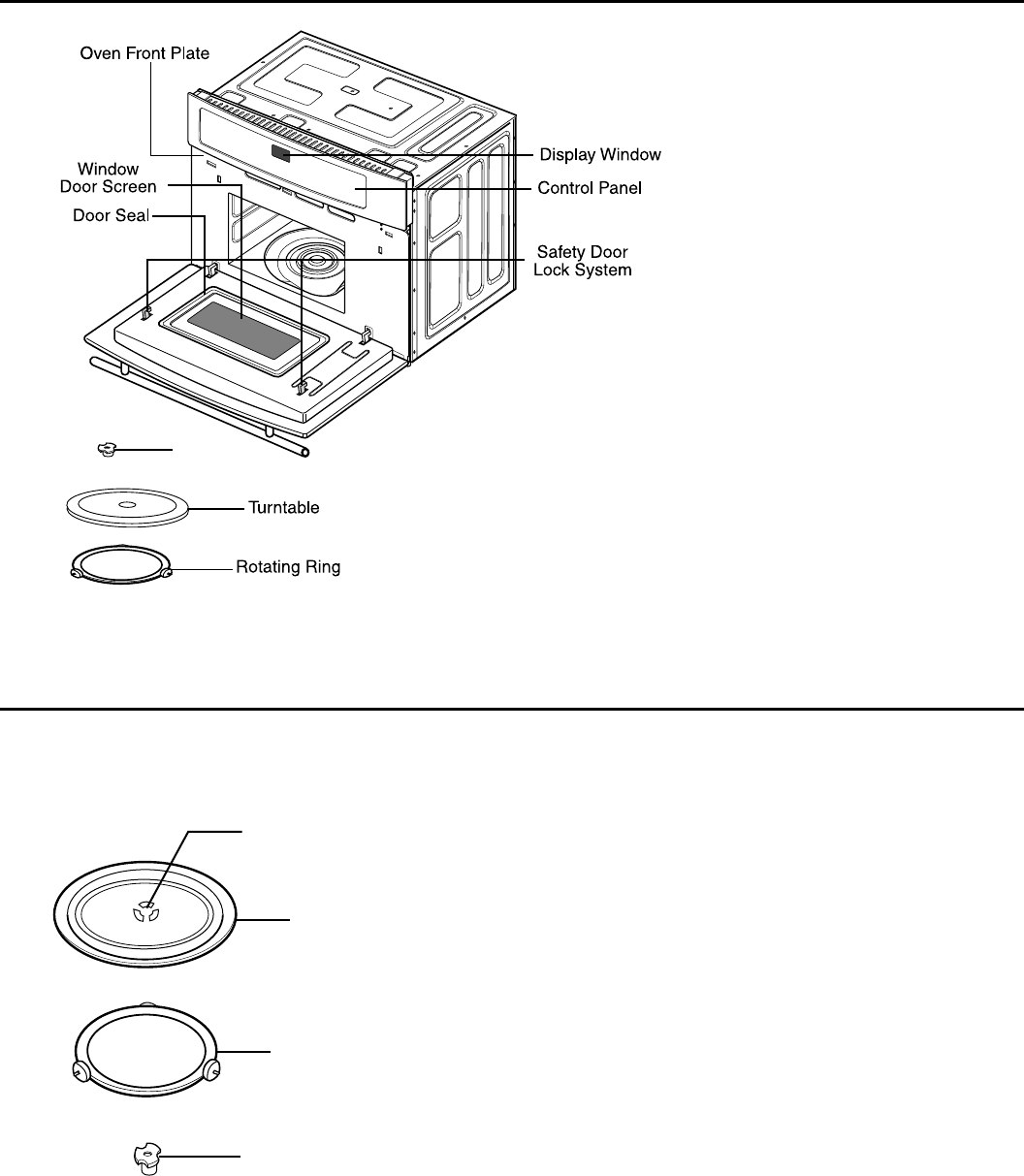
11
Feature Diagram
Your oven will be packed with the fol-
lowing materials:
Glass Turntable ......................1 each
Owner's Manual......................1 each
Turntable Shaft .......................1 each
Rotating Ring..........................1 each
This microwave oven is designed for
household use only. It is not recom-
mended for commercial purposes
and will void the warranty.
Turntable
Shaft
Turntable
Rotating
Ring
Hub
(Underside)
Turntable
Shaft
Turntable Installation
1. Place the rotating ring on the
cavity bottom.
2. Place the turntable on top of the
rotating ring as shown in the
diagram. Make sure the truntable
hub is securely locked in the
turntable shaft.
• Never place the turntable upside
down. The turntable should never
be restricted.
• Both turntable and rotating ring
must always be used during
cooking.
• All food and containers of food are
always placed on the turntable for
cooking.
• The turntable rotates clockwise and
counter clockwise; this is normal.
• If turntable or rotating ring cracks or
breaks, contact your nearest autho-
rized service center for more infor-
mation regarding replacement.
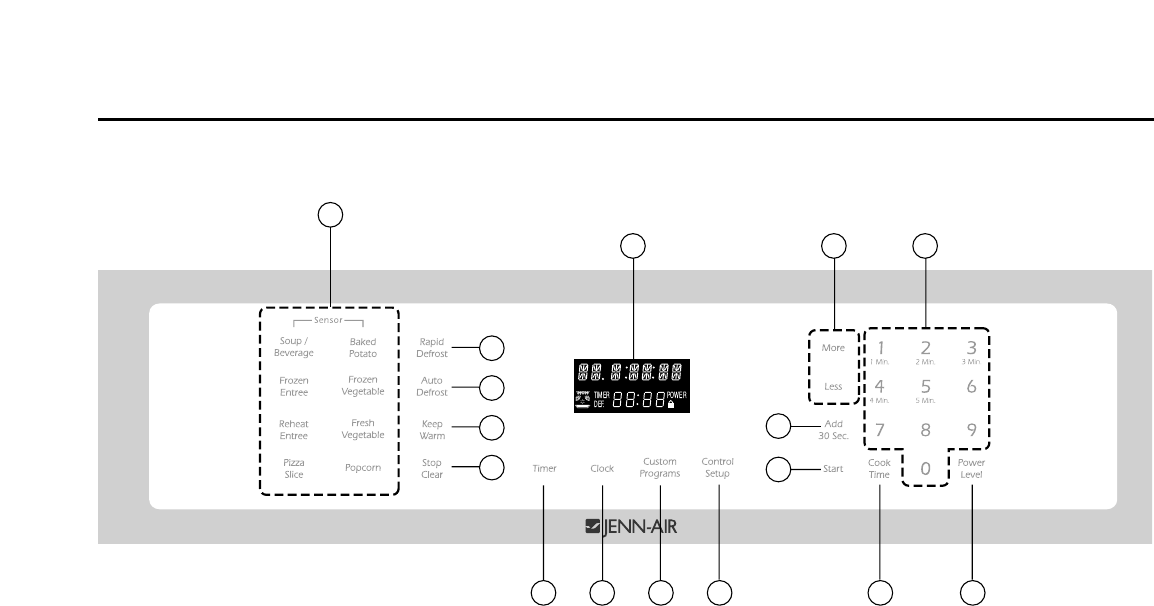
Control Panel
2
3
4
5
6
7 8 9
10
11
15 16
1
12
14
13
1. Display window
Upper line: Counts down cooking
time in minutes and/or seconds.
The word prompt scrolls to guide
you when setting the clock and at
every operating stage. It shows
power level when using timed
cooking.
Lower line: Shows clock time
when oven is not in use. Shows
kitchen timer time when this fea-
ture is selected.
2. Auto Sensor Keypads
- Reheat Entree
- Frozen Entree
- Pizza Slice
- Popcorn
- Baked Potato
- Fresh Vegetable
- Frozen Vegetable
These Sensor keypads provide
accurate and fast microwaving for
a variety of popular foods with no
quesswork.
- Soup/Beverage
This selection requires entry of
number of servings.
3. Rapid Defrost (Page 18)
Provides faster defrosting results.
This option is excellent for
thawing.
4. Auto Defrost (Page 19)
Provides through defrosting
results.
5. Keep Warm (Page 18)
This key safely keeps cooked
food warm in your oven for up to
99 minutes 99 seconds using
microwave energy.
6. Stop/Clear
Clears all previous settings it
pressed before cooking starts.
Press once to stop oven during
cooking press twice to stop and
clear all entries.
7. Timer (Page 13)
8. Clock (Page 13)
9. Custom Programs
10. Control Setup (Page 15)
Allows you to customize the
following oven feature settings.
11. More/Less (Page 16)
12. Add 30 sec. (Page 13)
13. Start
• To start cooking
• To set and cancel child to
account.
14. Number keys
Allows for the immediate start of
one of 5 present time from 1 to 5
minutes.
15. Cook Time
16. Power Level
12
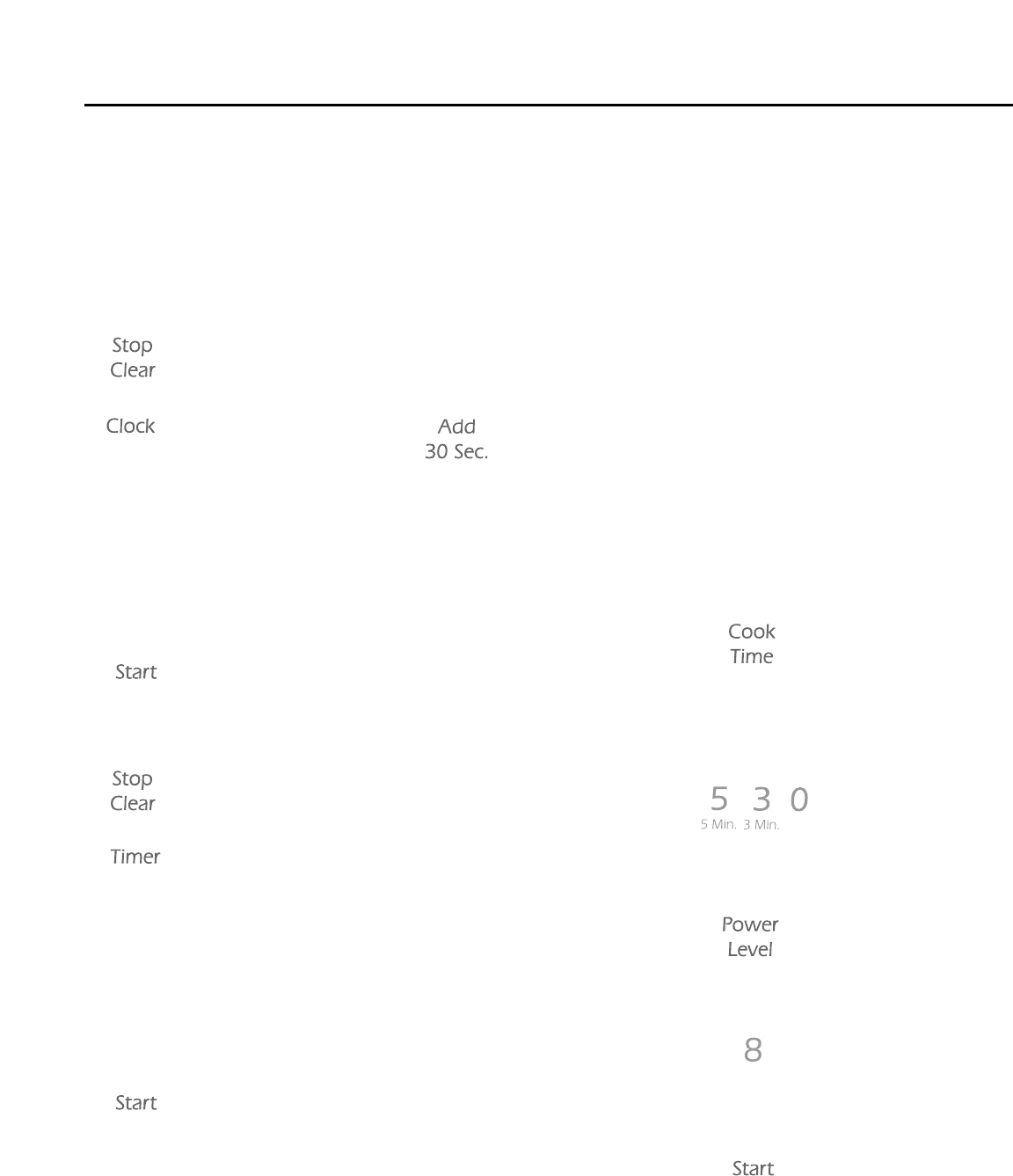
13
Operating Instructions
12-Hour Clock and Timer
Oven is equipped with a 12-hour
clock and a timer that can be set up
to 99 minutes and 99 seconds. Clock
does not display AM, PM or military
time.
Add 30 Sec.
A time-saving pad, this simplified
control lets you quickly set and start
microwave cooking without the need
to touch START.
NOTE: If you touch Add 30 Sec., it
will add 30 seconds up to 9 minutes
59 seconds:
TIME COOK
This function allows you to cook food
for a desired amount of time.
Because many foods need slower
cooking (at less than HI-POWER),
there are 10 power level settings in
addition to HI-POWER.
When cooking is complete, beeps
will sound. The word COOKEND
shows in the display window. Then
the oven shuts itself off.
NOTE: If you do not select the power
level, the oven will operate at power
HIGH. To set HI-POWER cooking,
skip steps 4 and 5 below.
Example: To cook food on 80%
Power (power 8) for 5 minutes 30
seconds
To set clock:
To set timer:
1. Touch
STOP/CLEAR
pad.
2. Touch CLOCK
pad.
• ENTER TIME OF
DAY scrolls
through display.
3. Enter desired time
by using digit
touch pads.
• TOUCH START
scrolls through
display.
4. Touch START.
1. Touch
STOP/CLEAR
pad.
2. Touch TIMER pad.
• ENTER TIME IN
MIN AND SEC
scrolls through
display.
3. Enter desired time
by using digit
touch pads.
• TOUCH START
scrolls through
display.
4. Touch START .
• To cancel timer
at any time,
press
STOP/CLEAR
pad.
Example: To set for 2 minutes
Touch Add 30 Sec.
4 times. The oven
begins cooking and
display shows time
counting down.
1. Touch COOKTIME
pad.
2. Touch number keys
• ENTER COOKING
TIME scrolls
through display.
3. Enter 5 minutes 30
seconds by touching
[5], [3], and [0].
Display scrolls the
words 5:30 TOUCH
START OR POWER.
4. Touch POWER
LEVEL. Display
scrolls the words
ENTER POWER
LEVEL 1 TO 10.
5. Touch 8.
To select power level
80%. Display scrolls
the words P80
TOUCH START.
6. Touch START.
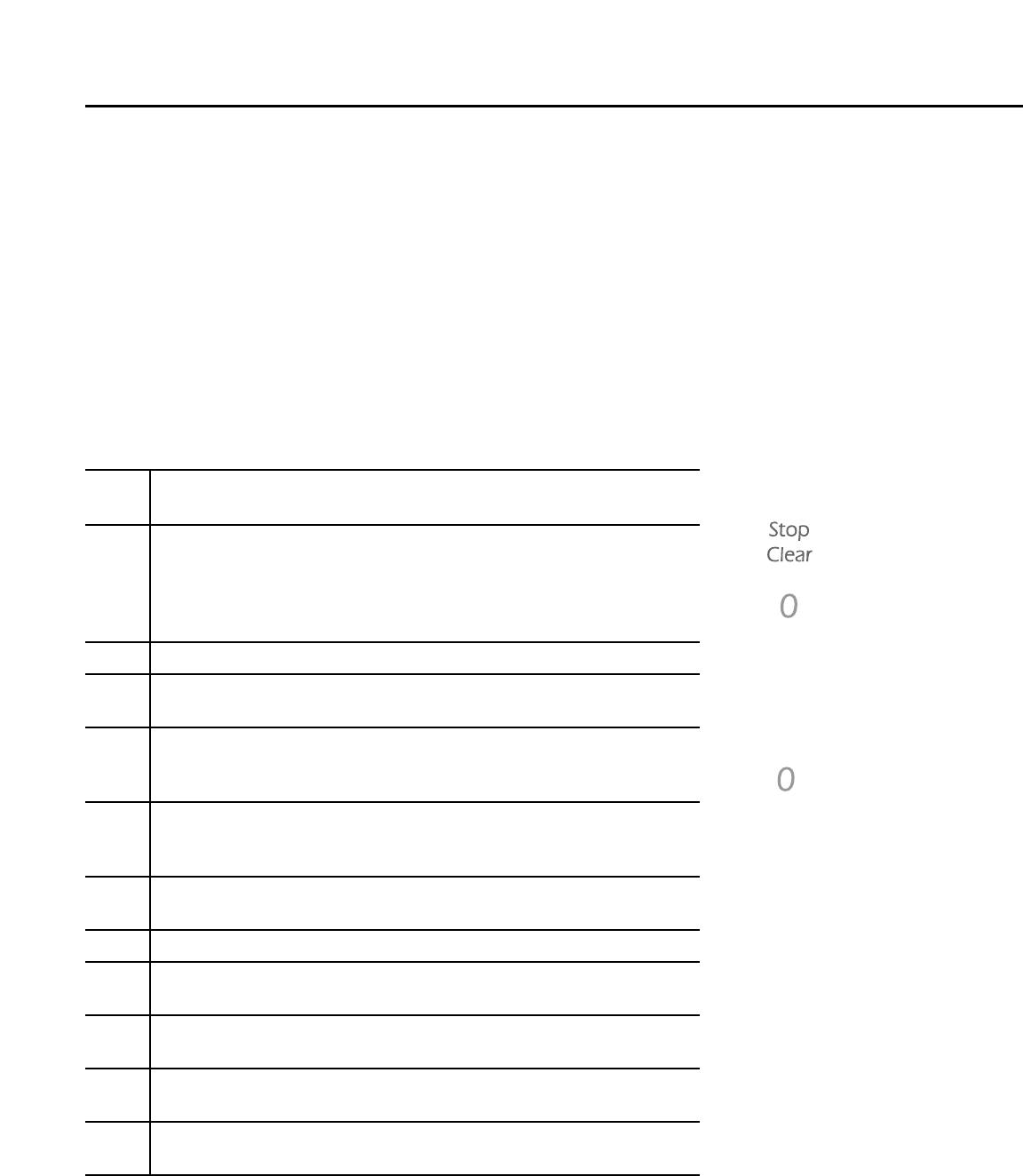
MULTI-STAGE TIME COOK
For Multi-Stage cooking, touch Cook Time and repeat Time Cook steps 3-5 on
previous page before touching the START pad.
Auto Defrost can be programmed before the first stage to defrost first and then
cook.
MICROWAVE POWER LEVELS
Your microwave oven is equipped with eleven power levels to give you maxi-
mum flexibility and control over cooking. The table below will give you some
idea of which foods are prepared at each of the various power levels.
CHILD LOCK
This safety feature prevents unwant-
ed oven operation. Once the child
lock is set, no cooking can take
place. The Child Lock feature is also
useful when cleaning the control
panel. Child Lock prevents accidental
programming when wiping the con-
trol panel.
If the CHILD LOCK is set and you
touch another cooking pad, the word
LOCKED shows in the display.
Cancel the child lock according to the
procedure below.
To set the child lock:
After the CHILD LOCK is turned off,
the time of day will return to the dis-
play window. The oven will operate
normally.
Power
Level Use
10 • Boiling water.
(HIGH) • Making candy.
• Cooking poultry pieces, fish and vegetables.
• Cooking tender cuts of meat.
• Whole poultry.
9 • Reheating rice, pasta and vegetables.
8 • Reheating prepared foods quickly.
• Reheating sandwiches.
7 • Cooking egg, milk and cheese dishes.
• Cooking cakes, breads.
• Melting chocolate.
6 • Cooking veal.
• Cooking whole fish.
• Cooking puddings and custard.
5 • Cooking ham, whole poultry, lamb.
• Cooking rib roast, sirloin tip.
4 • Thawing meat, poultry and seafood.
3 • Cooking less tender cuts of meat.
• Cooking pork chops, roast.
2 • Taking chill out of fruit.
• Softening butter.
1 • Keeping casseroles and main dishes warm.
• Softening butter and cream cheese.
0 • Standing time.
• Independent timer.
Microwave Power Level Chart
1. Touch STOP/
CLEAR.
2. Touch and hold 0
pad until the word
LOCKED
appears in the
display and two
beeps are heard.
To cancel the child lock:
Touch and hold 0
pad until the word
LOCKED
disappears in the
display.
14
Operating Instructions (cont’d)
LOCKED
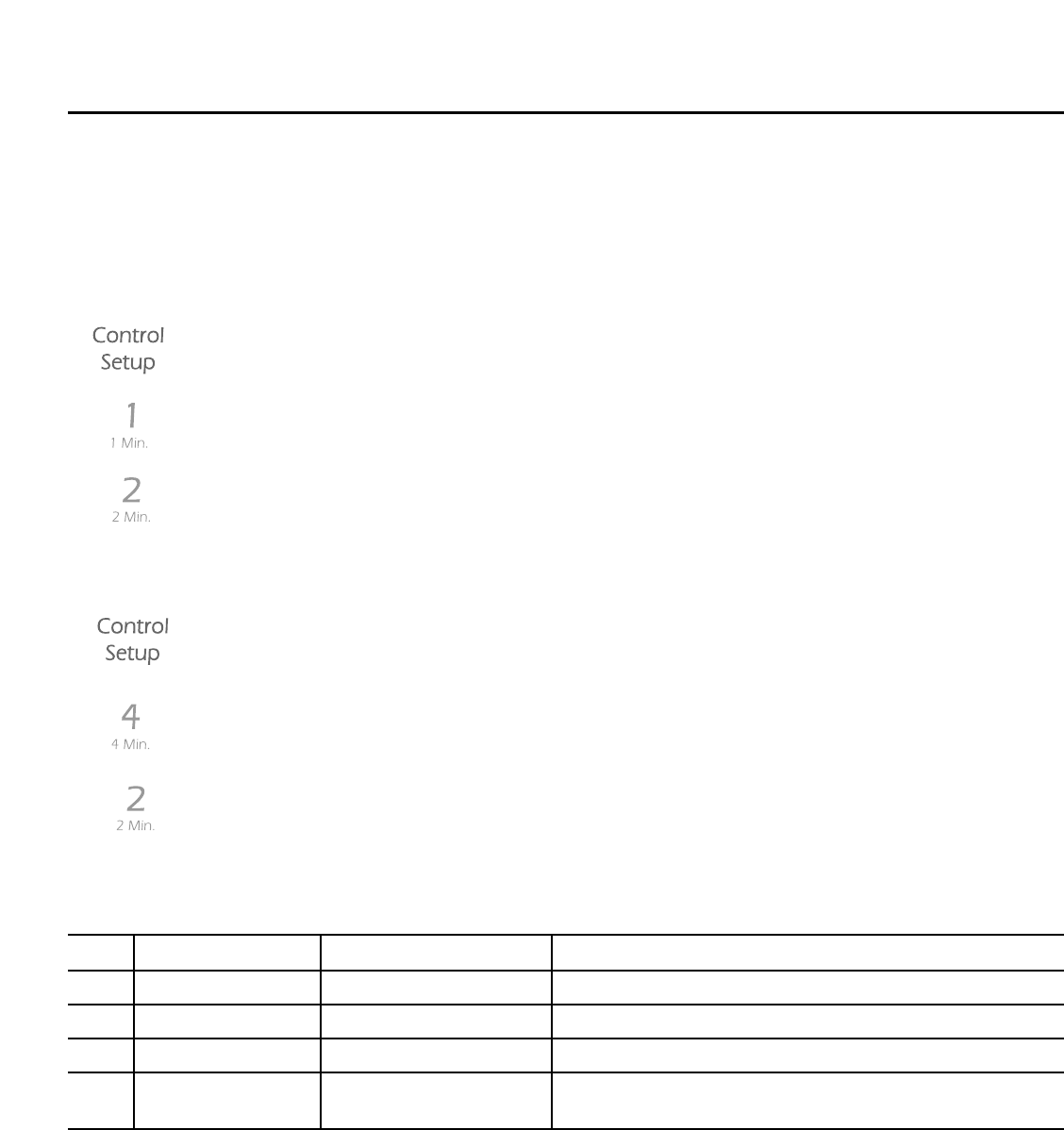
15
Operating Instructions (cont’d)
CONTROL SET-UP FUNCTION CHART
NO FUNCTION CHOICE REMARKS
1 SOUND ON / OFF Sound On or Sound Off All of the key sound and End of Cook sound on or off.
2 CLOCK ON / OFF Clock On or Clock Off When clock is off nothing displays when oven is not in use.
3 SCROLL SPEED Slow, Normal or Fast Controls speed of message that scrolls across display.
4 LBS. / KG Lbs. or Kg Set control to LBS. or KG for Auto Cook and Auto defrost
features.
NOTE: When the power cord is first plugged in, the default settings are Sound ON, Clock ON, Normal Speed and LBS.
CONTROL SET-UP
CONTROL SET-UP allows you to set the oven for your preferences.
You can select SOUND ON/OFF, CLOCK ON/OFF, SCROLL SPEED and LBS/KG.
Example 1: To turn off Sound of beeper.
1. Touch CONTROL SET-UP. Four modes show in the display repeatedly.
2. Touch 1. Display scrolls the words SOUND ON TOUCH 1 OFF TOUCH 2.
3. Touch 2. Display scrolls the words SOUND OFF. The current time will be displayed.
NOTE: To turn beep sound back on, repeat steps 1 - 2 then touch number 1.
Example 2: To select kg unit.
1. Touch CONTROL SET-UP.
Four modes show in the display continuously.
2. Touch 4.
Display scrolls the words LBS TOUCH 1 KG TOUCH 2.
3. Touch 2.
Display scrolls the words KG. The current time will be displayed.
NOTE: To select LBS., repeat steps 1-2 then, touch number 1.
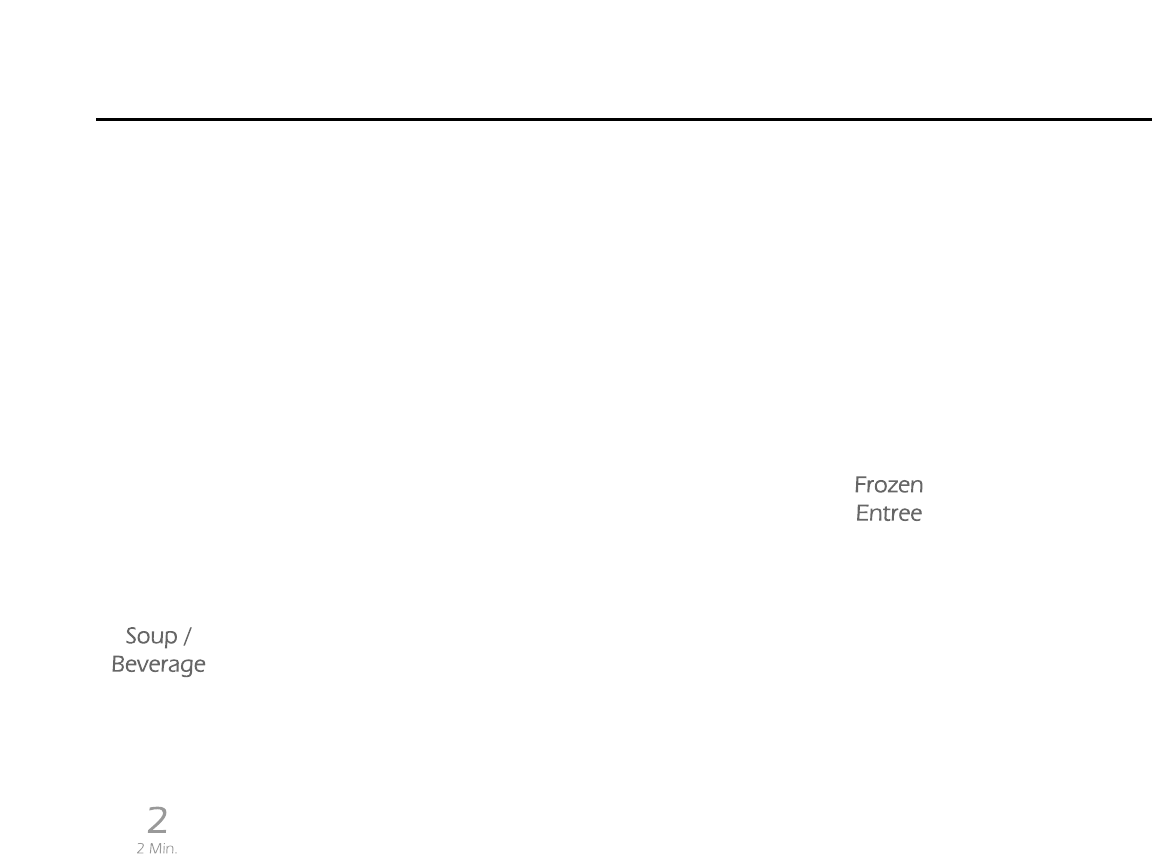
MORE/LESS
By using the MORE or LESS keys, all
of the Cook Time, Add 30 Sec.,
Sensor Cook programs can be
adjusted to cook food for a longer or
shorter time. Pressing MORE will
add 10 seconds to the cooking time
each time you press it. Pressing
LESS will subtract 10 seconds of
cooking time each time you press it.
You must wait until heating begins to
count down before adding or
subtracting time.
Example: To adjust the SENSOR
COOK (ex. beverage 2 servings)
cooking time for a longer time or
for a shorter time
1. Touch SOUP/
BEVERAGE.
Display scrolls the
words
SOUP/BEV
TOUCH 1 TO 3
SERVING.
2. Touch 2.
Display 2 SERV,
and automatically
Start.
NOTE:
Press the MORE or
LESS pad during
time countdown.
1. Touch FROZEN
ENTREE.
Display scrolls the
words FROZEN
ENTREE and
automatically
Start.
SENSOR COOK
OPERATION
INSTRUCTION
For most Sensor Cook programs, a
chart with specific food examples
and cooking instructions is provided
on the next pages. The Sensor Cook
system works by detecting a build-up
of vapor.
Hints
1. Make sure the door remains
closed.
2. Once the vapor is detected, two
beeps will sound.
3. Opening the door or touching
the STOP/CLEAR pad before
the vapor is detected will abort
the process. The oven will stop.
4. Before using Sensor Cook,
make sure the exterior of the
cooking container and the interi-
or of the oven are dry, to assure
the best results.
5. Room temperature should not
exceed 95° F.
6. Oven should be plugged in at
least 5 minutes before Sensor
Cooking.
Categories: Baked Potato
Frozen Entree
Frozen Vegetable
Reheat Entree
Fresh Vegetable
Pizza Slice
Popcorn
SENSOR COOK
SENSOR COOK allows you to cook
most of your favorite foods without
having to select cooking times and
power levels. This oven automatical-
ly determines the cooking time for
each food item. This feature has 8
food categories.
Example: To cook FROZEN
ENTREE
16
Operating Instructions (cont’d)

17
Operating Instructions (cont’d)
SENSOR COOK CHART
Code
1
2
3
4
5
6
7
8
Category
Soup/
Beverage
Baked
Potato
Frozen
Entree
Frozen
Vegetable
Reheat
Entree
Fresh
Vegetables
Pizza Slice
Popcorn
Direction
Cover soups with plastic wrap before heating. Stir soups
after heating. Use a microwave safe bowl, dish or mug.
Beverage do not need to be covered before heating. Stir
beverages after heating.
Pierce each potato with a fork and place on the oven tray
around the edge, at least one inch apart.
Remove from outer display package. Slit cover. If not in
microwave safe container, place on plate, cover with plastic
wrap and vent.
Remove from package, rinse off frost under running water.
Place in an appropriately-sized microwave container, cover
with plastic wrap and vent.
Arrange foods in center of plate or casserole and cover with
plastic wrap. Stir food after reheating. Food that can not be
stirred (e.g. lasagna) should be allowed stand covered for
approxinately 5 minutes after reheating.
Prepare as desired, wash, and leave residual water on the
vegetables. Place in an appropriately-sized microwave con-
tainer, cover with plastic wrap and vent.
Pizza should not be frozen. Place precooked pizza on a
paper towel or paper plate. Do not cover. Place Pizza point
toward the center.
CAUTION: Be careful when eating pizza heated in the
microwave. The Pizza surface and sauce can be very hot.
Follow package directions. Bag should be at room tempera-
ture. Do not use this feature; if popcorn bag size is other than
3.0 oz - 3.5 oz.
Amount
1 - 3 servings
(8 ozs/serving)
1 - 4 medium approx.
8 to 10 ozs each
10 - 21 ozs.
1 - 4 cups
4 - 20 ozs.
Entree, Casserole, Pasta
in sauce etc. Reheat dinner
plate like meat loaf dinner
on pizza slice function.
1 - 4 cups
1 - 3 slices (5 ozs/slice)
3.0 - 3.5 ozs
If you open the door or press STOP/CLEAR during sensing, the process will be canceled.
1) After popping, open bag carefully, popcorn and steam are extremly hot.
2) Do not reheat unpopped kernels or reuse bag. Overcooking can result in an oven fire.
3) Never use a brown paper bag for popping corn.
CAUTION
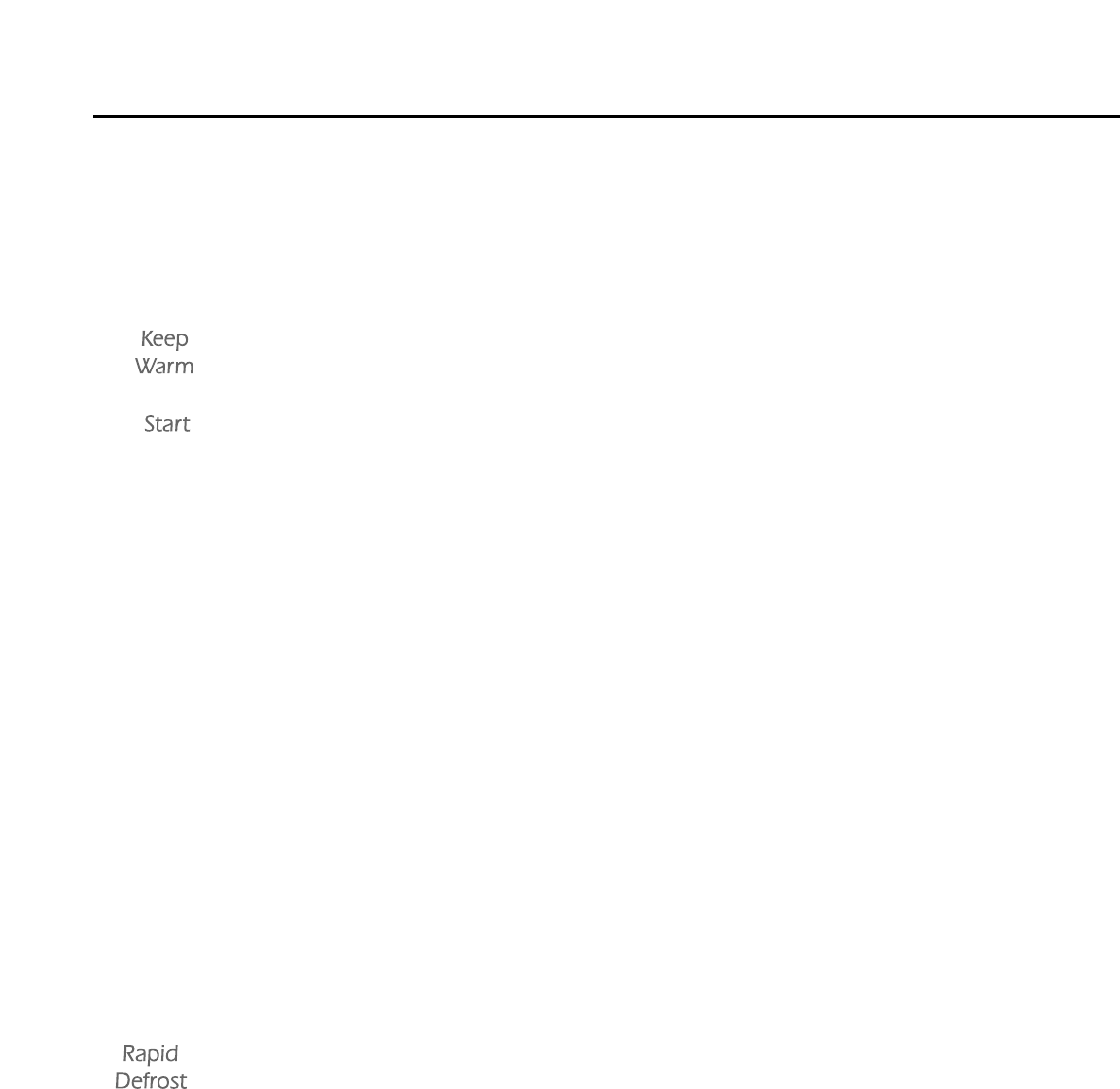
18
Operating Instructions (cont’d)
KEEP WARM
You can safely keep hot, cooked food warm in your microwave oven for up to
99 minutes, 99 seconds. You can use KEEP WARM by itself, or to automati-
cally follow a cooking cycle.
Example: To hold warm hot or cooked food
NOTE:
• KEEP WARM operates for up to 99 minutes, 99 seconds.
• Opening the oven door cancels KEEP WARM. Close the door and touch
KEEP WARM, then touch START if additional KEEP WARM time is desired.
• Food cooked should be covered during KEEP WARM.
• Pastry items (pies, turnovers, etc.) should be uncovered during KEEP
WARM.
• Complete meals kept warm on a dinner plate should be covered during
KEEP WARM.
• Do not use more than 1 complete KEEP WARM cycle (about 1 hour, 40 min-
utes). The quality of some foods will suffer with extended time.
1. Touch KEEP WARM.
Display scrolls the words KEEP WARM TOUCH START.
2. Touch START.
The word WARM will come on while the oven continue to
run.
RAPID DEFROST
This feature provides a quick defrost
for 1 lb. frozen ground beef.
Example: To defrost 1 lb. of frozen
ground beef
1. Touch RAPID
DEFROST.
The oven begins
the cooking with-
out the need to
touch START.
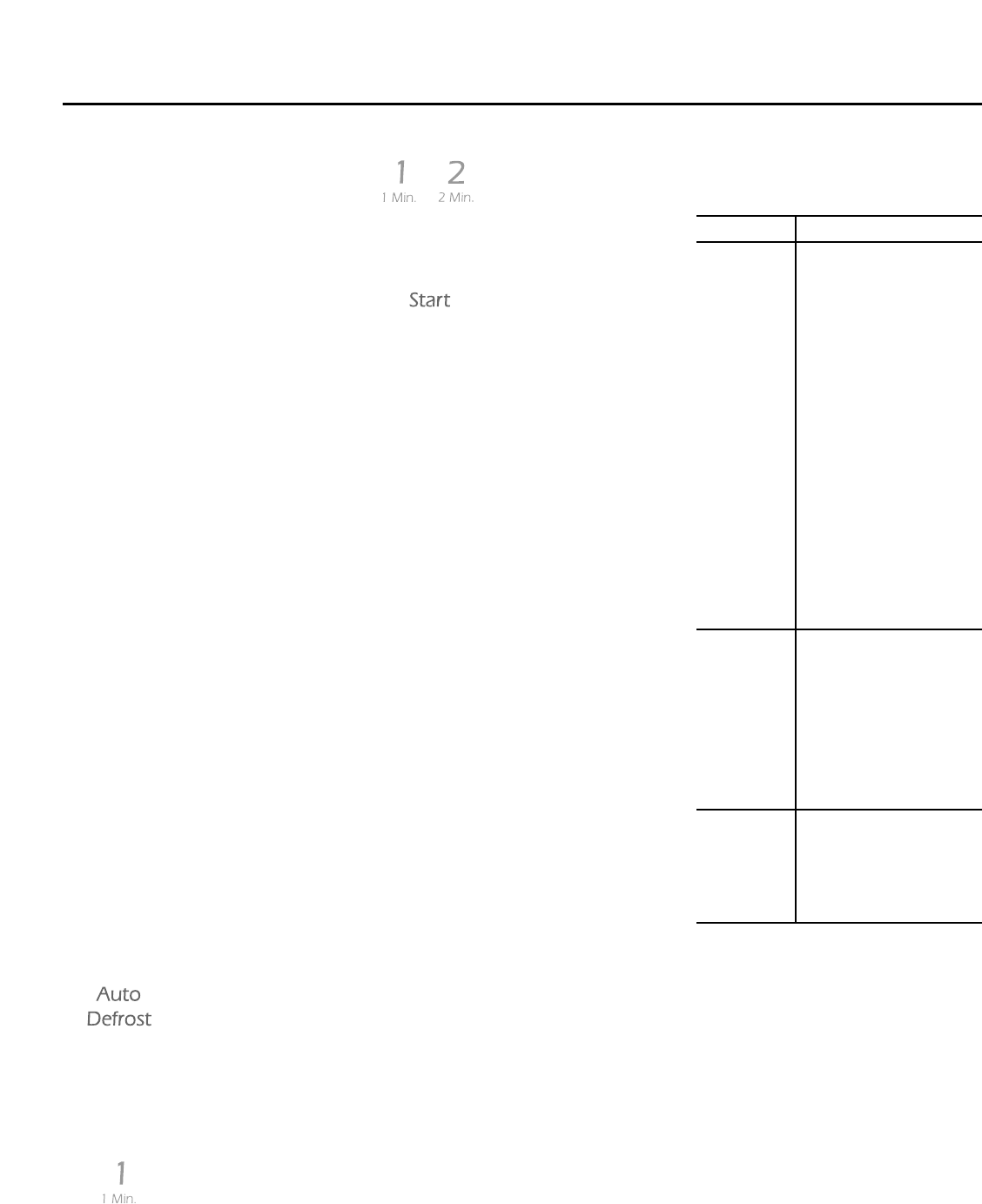
Operating Instructions (cont’d)
19
1. Touch AUTO
DEFROST.
Display scrolls the
words
MEAT TOUCH 1
POULTRY
TOUCH 2
FISH TOUCH 3.
2. Touch 1.
Display scrolls the
words ENTER
WEIGHT.
AUTO DEFROST
Three defrost sequences are preset
in the oven. The defrost feature pro-
vides you with the best defrosting
method for frozen foods. The cooking
guide will show you which defrost
sequence is recommended for the
food you are defrosting.
With the Auto Defrost feature, the
oven automatically sets the defrost-
ing time and power levels for you.
The oven automatically determines
required defrosting times for each
food item according to the weight you
enter.
For added convenience, the Auto
Defrost includes a built-in beep
mechanism that reminds you to
check, turn over, separate, or
rearrange. Three different defrosting
levels are provided.
1 MEAT
2 POULTRY
3 FISH
• You can select the category by
touching the numeric key 1
(MEAT), numeric key 2 (POUL-
TRY), and numeric key 3 (FISH)
after touching the AUTO
DEFROST pad.
• Available weight is 0.1-6.0 lbs.
(0.1-4.0 kgs).
Example: To defrost 1.2 lbs. of
ground beef
3. Enter the weight
by touching 1and
2.
Display scrolls the
words TOUCH
START.
4. Touch START.
Defrosting starts.
NOTE:
When you touch the START pad, the
display changes to defrost time count
down. The oven will beep during the
DEFROST cycle. At beep, open the
door and turn, separate, or rearrange
the food. Remove any portions that
have thawed. Return frozen portions
to the oven and touch START to
resume the defrost cycle.
• For best results, remove fish, shell-
fish, meat, and poultry from its orig-
inal closed paper or plastic pack-
age (wrapper). Otherwise, the
wrap will hold steam and juice
close to the foods, which can
cause the outer surface of the
foods to cook.
• For best results, shape your
ground meat into the form of a
doughnut before freezing. When
defrosting, scrape off thawed meat
when the beep sounds and contin-
ue defrosting.
• Place foods in a shallow container
or on a microwave roasting rack to
catch drippings.
• Food should still be somewhat icy
in the center when removed from
the oven.
AUTO DEFROST
SEQUENCE LIST
Food
BEEF
Ground beef, Round
steak, Cubes for stew,
Tenderloin steak, Pot
roast, Rib roast, Rump
roast, Chuck roast,
Hamburger patty.
LAMB
Chops (1 inch thick),
Rolled roast
PORK
Chops (1⁄2inch thick),
Hot dogs, Spareribs,
Country-style ribs.
Rolled roast, Sausage.
VEAL
Cutlets (1 lb. 1⁄2inch
thick)
POULTRY
Whole (under 4 lbs.),
Cut-up, Breasts
(boneless)
CORNISH HENS
Whole
TURKEY
Breast
FISH
Fillets, Whole steaks
SHELLFISH
Crab meat, Lobster
tails, Shrimp, Scallops
Sequence
1
MEAT
2
POULTRY
3
FISH

20
Fresh Vegetable Chart
Cook time
Vegetable Amount at HIGH Instructions Standing
(minutes) Time
Artichokes 2 medium 5-8 Trim. Add 2 tsp. water and 2 tsp. lemon juice. 2-3 minutes
(8 ozs. each) 4 medium 10-12 Cover. Cook stem end up.
Asparagus, 1 Ib. 3-7 Wash and turn half of spears around. 2-3 minutes
Fresh, spears Add 1⁄2cup water. Cover.
Beans, green and 1 lb. 5-7 Add 1⁄2cup water in 11⁄2qt. casserole. 2-3 minutes
wax Stir halfway through cooking.
Beets, Fresh 1 Ib. 7-10 Add 1⁄2cup water in 11⁄2qt. covered casserole. 2-3 minutes
Rearrange halfway through cooking.
Broccoli, Fresh, 1 Ib. 4-6 Place broccoli in baking dish. 2-3 minutes
spears Add 1⁄2cup water.
Cabbage, Fresh, 1 Ib. 4-6 Add 1⁄2cup water in 11⁄2qt. covered casserole. 2-3 minutes
chopped Stir halfway through cooking.
Carrots, Fresh, 2 cups 3-4 Add 1⁄4cup water in 1 qt. covered casserole. 2-3 minutes
sliced Stir halfway through cooking.
Cauliflower, 1 lb. 4-6 Trim. Add 1⁄4cup water in 1 qt. covered casserole. 2-3 minutes
Fresh, whole Stir halfway through cooking.
Celery, Fresh, 2 cups 3-4 Slice. Add 1⁄2cup water in 11⁄2qt. covered 2-3 minutes
sliced 4 cups 5-7 casserole.
Corn, Fresh 2 ears 4-6 Husk. Add 2 tsp water in 11⁄2qt. baking dish. 2-3 minutes
Cover.
Mushrooms, 1⁄2Ib. 2-3 Place mushrooms in 11⁄2qt. covered casserole. 2-3 minutes
Fresh, sliced
Parsnips, Fresh, 1 Ib. 4-6 Add 1⁄2cup water in 11⁄2qt. covered casserole. 2-3 minutes
sliced
Peas, Green, 4 cups 5-7 Add 1⁄2cup water in 11⁄2qt. covered casserole. 2-3minutes
Fresh Stir halfway through cooking.
Sweet Potatoes 2 medium 6-8 Pierce potatoes several times with fork. 2-3 minutes
Whole Baking 4 medium 14-16 2-3 minutes
(6-8 ozs. each)
White potatoes, 2 potatoes 6-8 Pierce potatoes several times with fork. 2-3 minutes
Whole Baking 4 potatoes 15-18 2-3 minutes
(6-8 ozs. each)
Spinach, Fresh, 1 Ib. 3-6 Add 1⁄2cup water in 2 qt. covered casserole. 2-3 minutes
leaf
Squash, Acorn or 1 medium 6-8 Cut squash in half. Remove seeds. 2-3 minutes
butternut, Fresh Place in 8x8-inch baking dish. Cover.
Zucchini, Fresh, 1 Ib. 5-8 Add 1⁄2cup water in 11⁄2qt. covered casserole. 2-3 minutes
sliced
Zucchini, Fresh, 1 Ib. 7-8 Pierce. Place on 2 paper towels. 2-3 minutes
whole Turn zucchini over and rearrange halfway
through cooking.
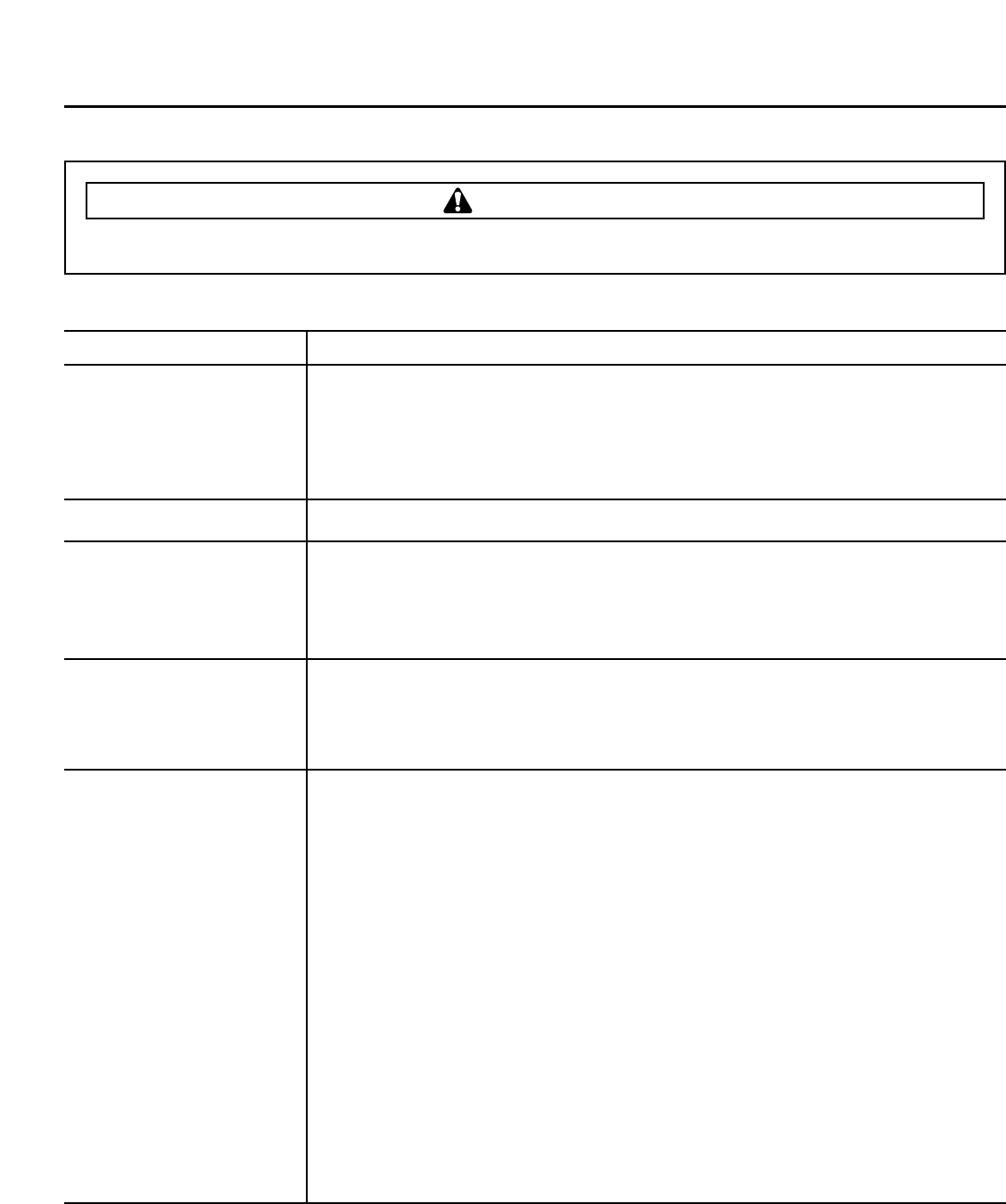
21
Care and Cleaning
To avoid risk of property damage, unplug the microwave oven or disconnect power at source by removing fuse or
throwing circuit breaker.
CAUTION
Before cleaning the oven, unplug the power supply cord of the oven or open the oven door to prevent an accidental
oven start.
Part Description
Inside of the Oven Use a damp cloth to wipe out crumbs and spillovers.
It is important to keep the area between door and cavity front clean to
assure a tight seal.
Remove greasy spatters with a sudsy cloth, then rinse and dry.
Do not use harsh detergent or abrasive cleaners.
Glass Tray The glass tray can be washed by hand or in the dishwasher.
Control Panel Wipe with a damp cloth followed immediately by a dry cloth.
The Child Lock feature is also useful when cleaning the control panel.
Child Lock prevents accidental programming when wiping the control
panel.
Door If steam accumulates inside or around the outside of the oven door,
wipe the panel with a soft cloth.
This may occur when the microwave oven is operated under high
humidity conditions and in no way indicates a malfunction of the unit.
Outside Oven Surface Wipe with a soft cloth and a mild detergent solution. Rinse and dry. Do not use harsh
detergent or abrasive cleaners.
To prevent damage to the operating parts inside the oven, water should not be
allowed to seep into the ventilation openings.
Stainless Steel
DO NOT USE ANY CLEANING PRODUCT CONTAINING CHLORINE BLEACH.
ALWAYS WIPE WITH THE GRAIN WHEN CLEANING.
Daily Cleaning/Light Soil - Wipe with one of the following - soapy water, white vinegar/water
solution, Formula 409 Glass and Surface Cleaner* or a similar glass cleaner - using a sponge or
soft cloth. Rinse and dry. To polish and help prevent fingerprints, follow with Stainless Steel
Magic Spray.*
Moderate/Heavy Soil- Wipe with one of the following - Bon Ami, Baking Soda or Soft Scrub* -
using a damp sponge or soft cloth. Rinse and dry. Stubborn soils may be removed with a damp
Scotch-Brite* pad; rub evenly with the grain. Rinse and dry. To restore luster and remove streaks,
follow with Stainless Steel Magic Spray.
Discoloration - Using a damp sponge or soft cloth, wipe with Cameo Stainless Steel Cleaner*.
Rinse immediately and dry. To remove streaks and restore luster, follow with Stainless Steel
Magic Spray.
After cleaning the oven, be sure the rotating ring and glass tray are in the correct position.
Press the STOP/CLEAR pad twice to reset any accidental key setting.
*Brand names for cleaning products are registered trademarks of the respective manufacturers.
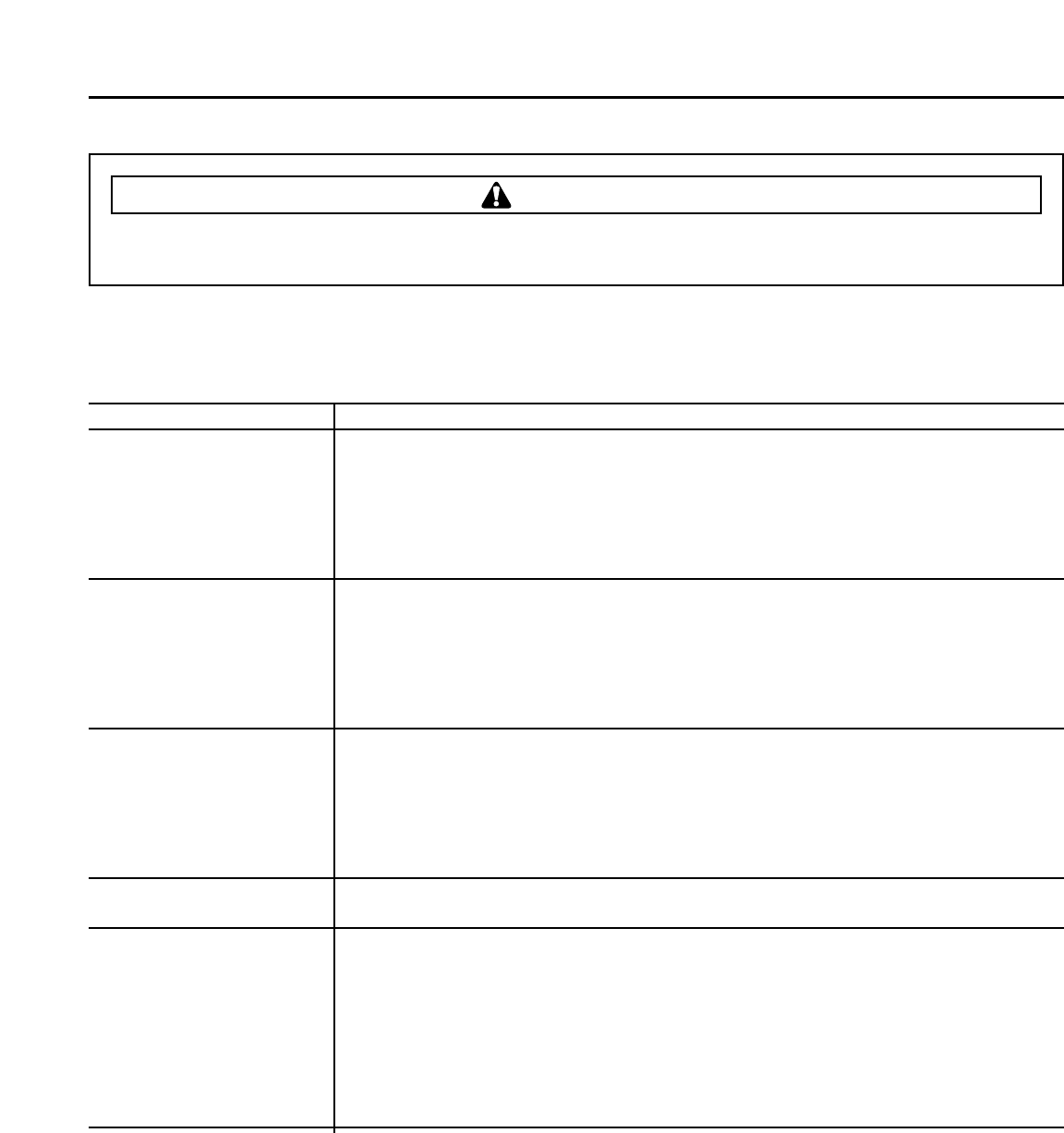
22
Troubleshooting
To avoid risk of severe personal injury, electrical shock or death, do not remove outer case at any time.
Only an authorized servicer should remove outer case.
WARNING
BEFORE CALLING FOR SERVICE
Check the following list to be sure a service call is necessary. A quick reference of this manual as well as reviewing addi-
tional information on items to check may prevent an unneeded service call.
ALL THESE THINGS ARE NORMAL
• Dull thumping sound during oven operation.
• Steam or vapor escaping from around the door.
• Light reflection around door or outer wrapper.
• Dimming oven light and change in blower sound during oven operation at power levels other than high.
• Some radio and TV interference might occur during operations. It is similar to the interference caused by other small
appliances such as mixers, blow dryer, etc.
Problem Possible Causes
Oven will not start • Electrical cord for oven is not plugged in.
-Plug into the outlet.
• Door is open.
-Close the door, open, and try again.
• Wrong operation is set.
-Check operation instructions.
Arcing or sparking • Materials to be avoided in microwave oven are used.
-Use microwave-safe cookware only.
• The oven is operated when empty.
-Do not operate with oven empty.
• Food soils remain in the cavity.
-Clean cavity with wet towel.
Uneven cooking or • Materials to be avoided in microwave oven are used.
poor defrosting -Use microwave-safe cookware only.
• Cooking time/Cooking power level is not suitable.
-Use correct time/Cooking power level.
• Food is not turned or stirred.
-Turn or stir food.
Overcooked foods • Cooking time/Cooking power level is not suitable.
-Use correct time/cooking power level when you cook the same food.
Undercooked foods • Materials to be avoided in microwave oven are used.
-Use microwave-safe cookware only.
• Food is not defrosted completely.
-Completely defrost food.
• Oven ventilation ports are restricted.
-Check to see that oven ventilation ports are not restricted.
• Cooking time/Cooking power level is not suitable.
-Use correct time/Cooking power level when you cook the same food.

23
Note

24
A/02/03 ©2003 Maytag Appliance Sales Co. Part No. /
Printed in Korea 02/03
Warranty
IN NO EVENT SHALL MAYTAG BE LIABLE FOR INCIDENTAL OR CONSEQUENTIAL DAMAGES.
This warranty gives you specific legal rights, and you may have others which vary from state to state. For example, some states do
not allow the exclusion or limitation of incidental or consequential damages, so this exclusion may not apply to you.
Full Two Year Warranty
For two (2) years from the date of original retail purchase, any part which fails in normal home use will be repaired
or replaced free of charge when carried into an authorized servicer.
Limited Parts Warranty
After the second year from the date of original retail purchase through the fifth year, the following parts which fail
in normal home use will be repaired or replaced free of charge for the part itself when carried into an authorized
servicer, with the owner paying all other costs, including labor, when the appliance is located in the United States
or Canada: (1) touch pad and microprocessor, (2) Magnetron tube.
Limited Parts Warranty Outside the United States and Canada
For one (1) year from the date of original retail purchase, any part which fails in normal home use will be repaired
or replaced free of charge for the part itself when carried into an authorized servicer, with the owner paying all other
costs, including labor, when the appliance is located outside the United States or Canada.
Canadian Residents
This warranty covers only those appliances installed in Canada that have been listed with Canadian Standards
Association unless the appliances are brought into Canada due to transfer or residence from the United States to
Canada.
What is not covered by these
warranties
• Replacement of household fuses, resetting of circuit breakers,
or correction to household wiring or plumbing.
• Normal product maintenance and cleaning, including light
bulbs.
• Products with original serial numbers removed, altered, or not
readily determined.
• Products purchased for commercial, industrial, rental, or
leased use.
• Products located outside of the United States or Canada.
• Premium service charges, if the servicer is requested to per-
form service in addition to normal service or outside normal
service hours or area.
• Adjustments after the first year.
• Repairs resulting from the following:
-
Improper installation, exhaust system, or maintenance.
- Any modification, alteration, or adjustment not authorized
by Maytag.
- Accident, misuse, abuse, fire, flood, or acts of nature.
- Connections to improper electrical current, voltage supply,
or gas supply.
- Use of improper pans, containers, or accessories that
cause damage to the product.
• Travel.
If you need service
❚Call the dealer from whom your appliance was purchased or
call Maytag Appliances Sales Company, Jenn-Air Customer
Assistance at 1-800-688-1100, USA and Canada to locate an
authorized servicer.
❚Be sure to retain proof of purchase to verify warranty status.
Refer to WARRANTY for further information on owner’s
responsibilities for warranty service.
❚If the dealer or service company cannot resolve the problem,
write to Maytag Appliances Sales Company, Attn: CAIR®
Center, P.O. Box 2370, Cleveland, TN 37320-2370, or call
1-800-688-1100 USA and Canada.
U.S. customers using TTY for deaf, hearing impaired or
speech impaired, call 1-800-688-2080.
NOTE: When writing or calling about a service problem,
please include the following information:
a. Your name, address and telephone number;
b. Model number and serial number;
c. Name and address of your dealer or servicer;
d. A clear description of the problem you are having;
e. Proof of purchase (sales receipt).
❚User’s guides, service manuals and parts information are
available from Maytag Appliances Sales Company, Maytag
Customer Assistance.
3828W5A2901